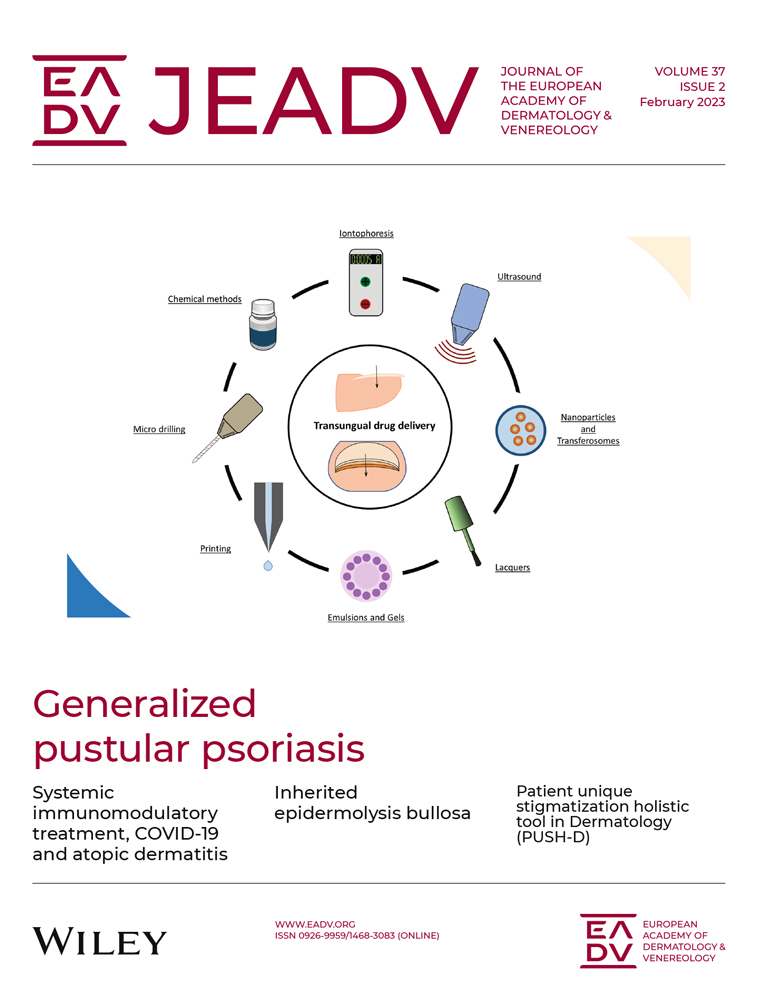Halo-like phenomenon in neurofibromatosis type 1: A potential new diagnostic criterion
This article relates to:
-
Response letter to: Halo-like phenomenon in neurofibromatosis type 1: A potential new diagnostic criterion
- Camilo Arias-Rodriguez,
- Julia Nowowiejska,
- Claudia Santoro,
- Giuseppe Argenziano,
- Teresa Russo,
- Silverio Perrotta,
- Vincenzo Piccolo,
- Volume 38Issue 7Journal of the European Academy of Dermatology and Venereology
- pages: e642-e643
- First Published online: December 8, 2023
Corresponding Author
Jia Zhang
Department of Dermatology, Xinhua Hospital Affiliated to Shanghai Jiaotong University School of Medicine, Shanghai, China
Institute of Dermatology, Shanghai Jiaotong University School of Medicine, Shanghai, China
Correspondence
Zhirong Yao, Jia Zhang and Ming Li, Department of Dermatology, Xinhua Hospital, Shanghai Jiaotong University School of Medicine, 1665 Kongjiang Road, Shanghai 200092, China.
Email: [email protected]; [email protected]; [email protected]
Search for more papers by this authorQianyue Xu
Department of Dermatology, Xinhua Hospital Affiliated to Shanghai Jiaotong University School of Medicine, Shanghai, China
Institute of Dermatology, Shanghai Jiaotong University School of Medicine, Shanghai, China
Search for more papers by this authorJinwen Shen
Department of Dermatology, Xinhua Hospital Affiliated to Shanghai Jiaotong University School of Medicine, Shanghai, China
Institute of Dermatology, Shanghai Jiaotong University School of Medicine, Shanghai, China
Search for more papers by this authorCorresponding Author
Ming Li
Department of Dermatology, Xinhua Hospital Affiliated to Shanghai Jiaotong University School of Medicine, Shanghai, China
Institute of Dermatology, Shanghai Jiaotong University School of Medicine, Shanghai, China
Correspondence
Zhirong Yao, Jia Zhang and Ming Li, Department of Dermatology, Xinhua Hospital, Shanghai Jiaotong University School of Medicine, 1665 Kongjiang Road, Shanghai 200092, China.
Email: [email protected]; [email protected]; [email protected]
Search for more papers by this authorCorresponding Author
Zhirong Yao
Department of Dermatology, Xinhua Hospital Affiliated to Shanghai Jiaotong University School of Medicine, Shanghai, China
Institute of Dermatology, Shanghai Jiaotong University School of Medicine, Shanghai, China
Correspondence
Zhirong Yao, Jia Zhang and Ming Li, Department of Dermatology, Xinhua Hospital, Shanghai Jiaotong University School of Medicine, 1665 Kongjiang Road, Shanghai 200092, China.
Email: [email protected]; [email protected]; [email protected]
Search for more papers by this authorCorresponding Author
Jia Zhang
Department of Dermatology, Xinhua Hospital Affiliated to Shanghai Jiaotong University School of Medicine, Shanghai, China
Institute of Dermatology, Shanghai Jiaotong University School of Medicine, Shanghai, China
Correspondence
Zhirong Yao, Jia Zhang and Ming Li, Department of Dermatology, Xinhua Hospital, Shanghai Jiaotong University School of Medicine, 1665 Kongjiang Road, Shanghai 200092, China.
Email: [email protected]; [email protected]; [email protected]
Search for more papers by this authorQianyue Xu
Department of Dermatology, Xinhua Hospital Affiliated to Shanghai Jiaotong University School of Medicine, Shanghai, China
Institute of Dermatology, Shanghai Jiaotong University School of Medicine, Shanghai, China
Search for more papers by this authorJinwen Shen
Department of Dermatology, Xinhua Hospital Affiliated to Shanghai Jiaotong University School of Medicine, Shanghai, China
Institute of Dermatology, Shanghai Jiaotong University School of Medicine, Shanghai, China
Search for more papers by this authorCorresponding Author
Ming Li
Department of Dermatology, Xinhua Hospital Affiliated to Shanghai Jiaotong University School of Medicine, Shanghai, China
Institute of Dermatology, Shanghai Jiaotong University School of Medicine, Shanghai, China
Correspondence
Zhirong Yao, Jia Zhang and Ming Li, Department of Dermatology, Xinhua Hospital, Shanghai Jiaotong University School of Medicine, 1665 Kongjiang Road, Shanghai 200092, China.
Email: [email protected]; [email protected]; [email protected]
Search for more papers by this authorCorresponding Author
Zhirong Yao
Department of Dermatology, Xinhua Hospital Affiliated to Shanghai Jiaotong University School of Medicine, Shanghai, China
Institute of Dermatology, Shanghai Jiaotong University School of Medicine, Shanghai, China
Correspondence
Zhirong Yao, Jia Zhang and Ming Li, Department of Dermatology, Xinhua Hospital, Shanghai Jiaotong University School of Medicine, 1665 Kongjiang Road, Shanghai 200092, China.
Email: [email protected]; [email protected]; [email protected]
Search for more papers by this authorJia Zhang, Qianyue Xu and Jinwen Shen contributed equally to this work.
Open Research
DATA AVAILABILITY STATEMENT
Data available on request from the author.
REFERENCES
- 1Boyd KP, Korf BR, Theos A. Neurofibromatosis type 1. J Am Acad Dermatol. 2009; 61(1): 1–14. quiz 15–6.
- 2DeBella K, Szudek J, Friedman J. Use of the national institutes of health criteria for diagnosis of neurofibromatosis 1 in children. Pediatrics. 2000; 105: 608–14.
- 3Neri I, Lambertini M, Tengattini V, Rivalta B, Patrizi A. Halolike phenomenon around a cafe au lait spot superimposed on a Mongolian spot. Pediatr Dermatol. 2017; 34(3): e152–3.
- 4Koga M, Yoshida Y, Imafuku S. Clinical characteristics of the halo phenomenon in infants with neurofibromatosis 1: a case series. Acta Derm Venereol. 2018; 98(1): 153–4.
- 5Zhang J, Tong H, Fu X, Zhang Y, Liu J, Cheng R, et al. Molecular characterization of NF1 and neurofibromatosis type 1 genotype-phenotype correlations in a Chinese population. Sci Rep. 2015; 5:11291.
- 6Zhang J, Qin W, Hua S, Li M, Tang Y, Yao Z. Café au lait macules overlying segmental macular hyperpigmentation in a paediatric patient: an early sign for mosaic neurofibromatosis type 1. Br J Dermatol. 2021; 184(4): 742–3.
- 7Ahn JS, Kim SD, Hwang JH, Youn SW, Kim KH, Park KC. Halo-like disappearance of mongolian spot combined with café au lait spot. Pediatr Dermatol. 1998; 15(1): 70–1.
- 8Legius E, Messiaen L, Wolkenstein P, Pancza P, Avery RA, Berman Y, et al. Revised diagnostic criteria for neurofibromatosis type 1 and Legius syndrome: an international consensus recommendation. Genet Med. 2021; 23(8): 1506–13.




